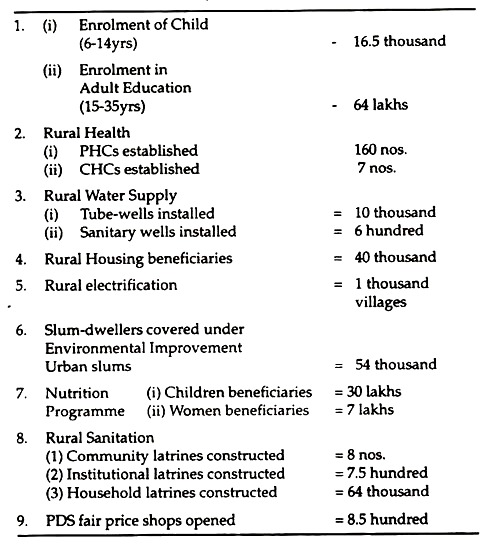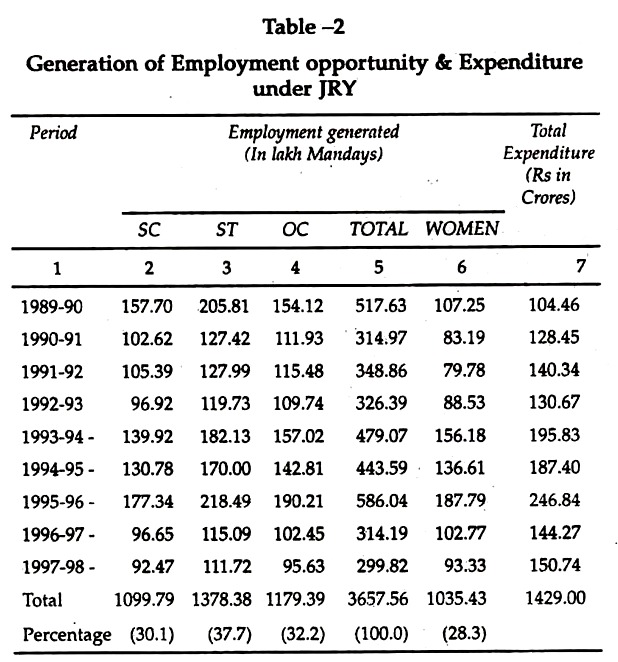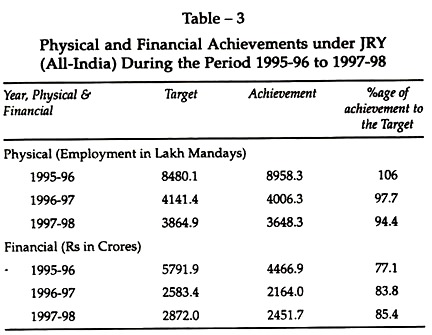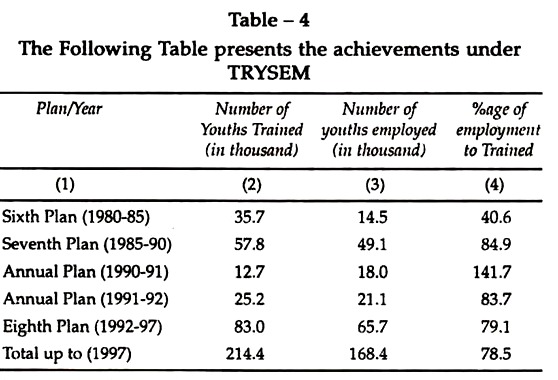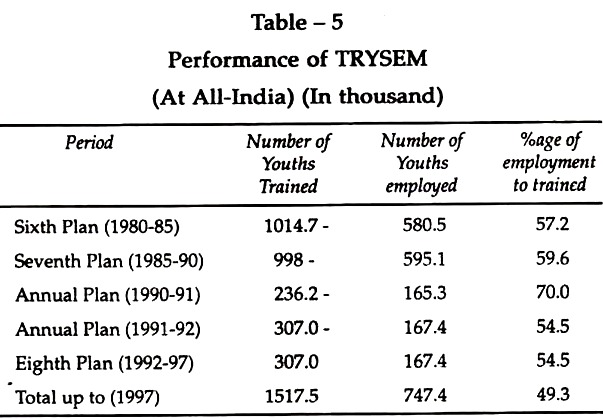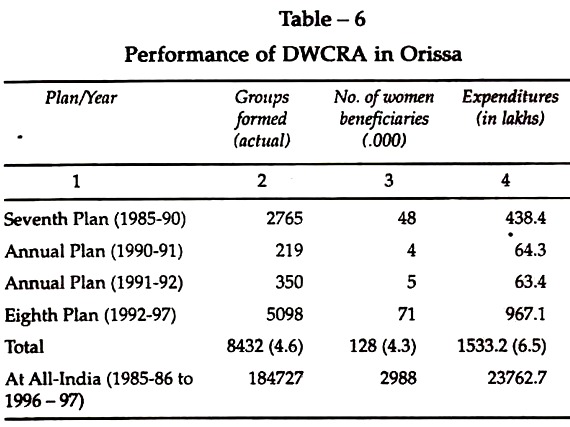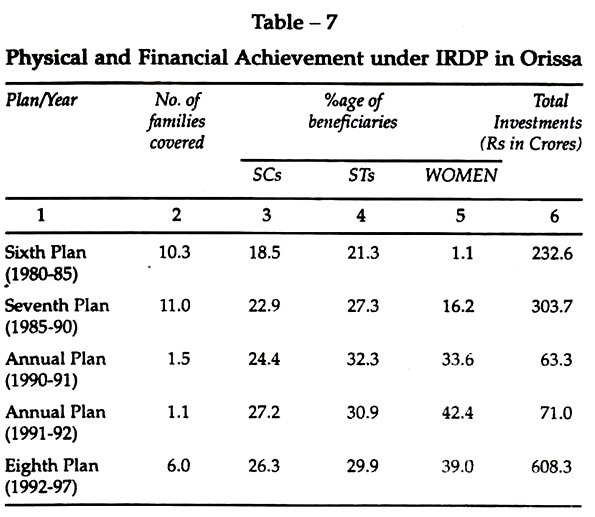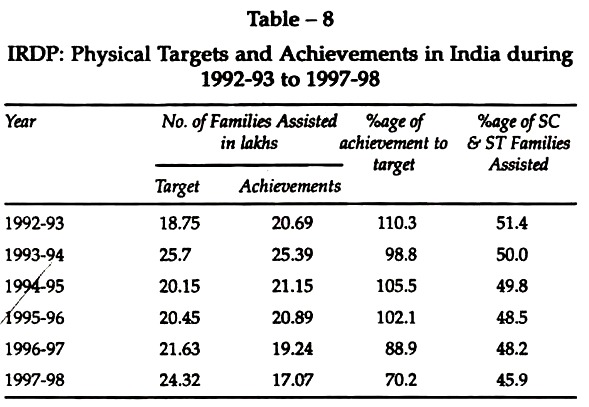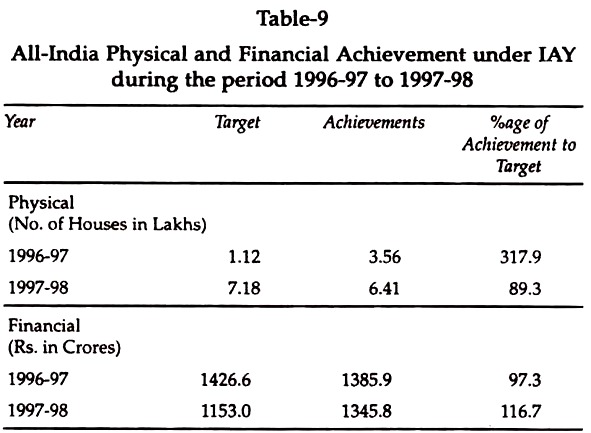After reading this essay you will learn about the rural development programmes that are followed in India.
Rural Development Programmes of India
Essay Contents:
- Essay on the 20 – Point Programme
- Essay on the Minimum Needs Programme (MNP)
- Essay on the Food For Work Programme (FFW)
- Essay on the National Rural Employment Programme (NREP)
- Essay on the Rural Landless Employment Guarantee Programme (RLEGP)
- Essay on Jawahar Rozgar Yojana (JRY)
- Essay on the Training of Rural Youth for Self-Employment (TRYSEM)
- Essay on Self-Employment for the Educated Unemployed Youths (SEEUY)
- Essay on the Development of Women and Children in Rural Areas (DWCRA)
- Essay on the Integrated Rural Development Programme (IRDP)
- Essay on the Economic Rehabilitation of Rural Poor ERRP (in Orissa)
- Essay on the Indira Awas Yojana (IAY)
- Essay on the Integrated Rural Energy Planning Programme (IREP)
- Essay on the Employment Assurance Scheme (EAS)
- Essay on the Swarnajayanti Gram Swarozgar Yojana (SGSY)
Essay # 1. 20 – Point Programme:
The 20-point Economic Programme was announced on 1st July 1975.
This programme has three particular aims, these are:
(1) To ensure Social Justice
(2) To relieve Unemployment
(3) To eradicate poverty
Under this programme priority areas were identified, which required positive and immediate action. The 20-point programme did not replace or supplant the Fifth Plan. It only assigned special assistance to limited number of urgent programmes for economic and social reform which did not disturb the basic priorities of the plan. Many of the items of the 20-point programme fall within the preview of State sector.
The salient feature of the 20-point programme were:
(1) Meeting the challenges in the price front.
(2) Effective land Reforms and distribution of surplus land among the landless.
(3) Home-sites to Landless Labourers.
(4) Banning of Bonded labour.
(5) Liquidation of Rural Indebtedness.
(6) Enhanced Minimum wages for Agricultural labourers.
(7) Expansion of Irrigation Facilities.
(8) Greater supply of Electric Power.
(9) Special Measures for Development of Handlooms.
(10) More Adequate Supply of Controlled cloth.
(11) Regulation of Private ownership of Urban Land.
(12) Checking Tax Evasion in respect of Urban Property.
(13) Intensification of measures to prevent smuggling.
(14) Liberalisation of Industrial Licenses.
(15) Greater participation by workers in Industrial Management.
(16) National permits for Road Transport operators.
(17) Income Tax exemption for people with Moderate Incomes.
(18) Relief for poor students who reside in hotels outside statutory rationing areas.
(19) Provision of Textbooks and writing materials to students at concessional rates.
(20) Widening the scope of the Apprenticeship Act.
During its first phase period between 1975 to 1977 have directly or indirectly helped the rural poor. Furthermore, during the Janata Government rule between 1977-79 the programme was shelved. This programme was once again came to the forefront of action with the return of Congress Government to power in 1980.
The Commercial Bank was directed to implement the 20-point programme. The programme was restructured on August 20; 1986 and came into implementation from April 1 1987. The avowed objective of the comprehensive new programme has been to eradicate poverty and create full employment.
The salient features of the revised programme are:
(1) Attack on Rural Poverty
(2) Promotion of rain fed agriculture
(3) Better use of irrigation water
(4) Bigger harvest
(5) Enforcement of land reforms
(6) Special programmes for rural labour
(7) Clean drinking water
(8) Health for all
(9) Two- child norms
(10) Expansion of education
(11) Justice to Scheduled Castes and Tribes
(12) Equality for women
(13) New opportunity for youth
(14) Housing for the people
(15) Improvement of slums
(16) New strategy-for forestry
(17) Protection of environment
(18) Concern for the consumer
(19) Energy for the village and
(20) A responsive Administration.
The revised 20-Point Programme seeks to achieve four major objectives as:
(1) To check inflation and ensures adequate supply of essential commodities.
(2) To uplift the downtrodden sections of the Society by providing them economic and social justice.
(3) To protect consumers
(4) To offer responsible and cooperative administration.
The new 20-Point Programme is intended for the amelioration of the economic conditions of the weaker sections of the society. The State Orissa has taken adequate care to implement the programme effectively throughout the state.
Particular care has been taken to allocate adequate Funds in the budget every year for different schemes under 20-Point Programme. During the Sixth Plan Period more than 85 per cent of the plan allocation have been provided for the purpose.
The State Government has set up Monitoring Committees at different level and the programmes are reviewed by the officials and non-officials in different forums starting from the block to the State level. The committees set up at different level take stock of the manner of implementation of the programmes and suggest remedial measures to remove the operational constraints in the field.
Each district has been placed in-charge of a member of the Council of Ministers so that the implementation of the various programmes can be monitored in-depth through the District Level Committee under his Chairmanship.
Recognising the fact that the people’s participation is most important in effective implementation of the programmes at the grass-root level, the State Government have associated people’s representative in various Committees set up at different levels for review of 20-point programme. Most of the development programmes under 20-point programme were implemented along with other developmental programmes like IRDP, ERRP, NREP, and RLEGP etc.
However, during Sixth Five Year Plan (1980-85) the achievement under 20-Point Programme was as follows:
(1) About 17.4 lakh hectares of irrigation potential was created from different irrigation projects.
(2) In the State, about 1.3 lakh areas of land have been distributed among 1-lakh beneficiaries.
(3) The minimum wages for agricultural labourers have been raised from Rs 4/- per day in 1980 to Rs 7.50 per day.
(4) About, 2 thousand bonded labourers were rehabilitated.
(5) In the state about 40 thousand tube-wells and 10 thousand sanitary wells were installed.
(6) During the plan period about 10 thousand houses were constructed by spending Rs 3 Crores and distributed to homestead less family.
(7) In the state about 6.5 thousand additional villages were electrified.
(8) Under Family Planning Programme about 6.5 lakh sterilization was made. As a measure of incentive, the State Government has introduced a scheme of awards for their field workers. The “Green Card” system has also been introduced to provide incentive to the employees, who voluntarily accept terminal methods of family planning.
(9) Universal Health Care facilities were extended under the programme during the plan period about 25 thousand leprosy patients was treated and equal number of TB cases was treated. Steps were also taken to control blindness.
(10) Non-formal education centres and non-formal education centre exclusively for girls were also implemented.
During the Sixth Plan Period about 20 thousand fair price shops were opened for the betterment of public distribution system.
About 2.5 lakh Artisan units with an investment of Rs 25.6 Crores were established during the said plan period.
To improve the quality of working of public enterprises & the State Government established 31 public sector undertakings and two co-operative corporations. Besides, the Government reorganised other public sector undertakings.
Government of India has issued specific guidelines from time to time for effective implementation of the objectives of the programme so that the goals can be achieved within the stipulated time period. As per the guidelines different committees have been constituted at various levels to review the implementation of the programme in the grass root level.
1. State level committee for review of Implementation of Plan Programme.
2. Committee of officers for review of implementation of Plan Programmes.
3. District level committee.
4. Sub-divisional level committee.
5. Block level committee.
Realising the importance of Voluntary Organisations in the effective Implementation of this programme, consultative committees on Voluntary Organisations have also been constituted at state and district level.
Basing on the assessment criteria, state-wise performance score card was compiled by the Ministry of Programme Implementation, Government of India, Orissa stood at second position during 1987-88 and 1988-89, seventh during rest of the years of Seventh Five Year Plan.
During different years of the Eighth Five Year Plan, Orissa secured 12th, 8th, 11th and 4th position in the years 1992-93, 93-94, 94-95 and 95-96 respectively.
In order to accelerate the performance at the field level, district wise assessment of performance under selected items of 20-Point Programme is also made at the State level following the assessment criteria adopted by Government of India.
Essay # 2. Minimum Needs Programme (MNP):
The concept of Minimum needs accepts the view that there is some nationally accepted norms of social services, which should be provided to all classes of people within a time, bound programme. The provision of free or subsidized services through public agencies is expected to improve the consumption levels of those below the poverty line.
Apart from social justice, improved consumption may be expected to contribute to the productive efficiency of the rural and urban workers. This programme was included in Fifth Five Year Plan as an investment on human resources development. The programme resulted from the experience of earlier plans that plan outlays on Social Services were given low priority and were reduced in situations of resources scarcity.
It was also experienced that benefits of social services failed to reach the Weaker Sections without conscious effort to that end. There were also Inter-and Intra-regional disparities in social consumption resulting from differences in outlays.
The Fifth Plan therefore introduced a Minimum Need Programme (MNP) with the following components:
Elementary and adult education.
1. Rural Health.
2. Rural water supply.
3. Rural Roads.
4. Rural Electrification.
5. Housing assistance to rural landless labourers
6. Environmental improvement of urban slums.
7. Nutrition.
The programme was also launched in Orissa during the Fifth Plan Period. The important objective of the plan was to increase the consumption standard of the lowest 30 per cent of the population.
Since such consumption could be partly private and partly social, the National Programme of Minimum Needs assumed considerable importance. Total Funds for Minimum Needs Programme was Rs 216.1 Crores during Fifth Plan. This accounted for about 25.8 per cent of the total plan outlay for the said plan.
During Fifth Plan Period about 6 thousand villages were electrified and 4.5 thousand irrigation pumps were energised. The Fifth Plan followed by two annual plans i.e; 1978-79 and 1979-80 where about 3 thousand villages were electrified and 6 thousand irrigation pumps were installed. Under the revised MNP, about 323 roads covering 3,586 kilometres were completed during the mentioned period.
The enrollment of students in Primary and Middle School during the period from 1974 to 1980 has increased about more than 100 per cent and 150 per cent respectively. After adoption of Minimum Needs Programme the health services of the State has also received utmost attention.
As a part of MNP 77 selected PHCs were upgraded to 30 bedded rural hospitals, besides, 942 sub-centres, 1100 family welfare centres were established and about 131 PHC out of 309 PHCs buildings were electrified. About 10 thousand villages were provided drinking water facilities by either tube- wells or sanitary wells.
Under MNP about 8 thousand acres of land were distributed to about 162 lakh families (@ 0.04 acres per family) Besides, about 13 thousand houses were constructed. Under the improvement of urban slums scheme 51 thousand inhabitants of the weaker sections were received benefits. It is also observed that 2.5 lakh beneficiaries were provided with local food under the MNP.
In the Sixth Plan (1980-85), it has been mentioned that the programmes under MNP will have to taken as a package and related to specific areas and beneficiary groups.
In order to meet this approach the Minimum Needs Programme have been revised as:
(1) The landless labourers to be provided with house sites along with financial help for building their own houses is to be extended for urban areas.
(2) To provide safe drinking water facilities to all the villages.
(3) The coverage of mid-day meal scheme for under nourished children and supplementary nutrition programme for mothers and infants to be expanded to the block which have high concentration of Scheduled Castes, Scheduled Tribes and of people below the poverty line.
The enrolment of children in schools gathered importance as the National Policy on Education seeks to provide free and compulsory education to all children up to 14 years of age. In this respect, the Sixth Plan target of 39.4 lakh children was fully achieved.
About 2 lakh people were enrolled in about 6.9 thousand centres under adult education programme. Under the programme 20 PHCs were opened, 17 PHCs were upgraded, about 100 Subsidiary Health Centres (SHCs) were converted to dispensaries and about 23 hundred health sub-centres were also established.
During the plan period about 40 thousand tube-wells and 10 thousand sanitary wells were installed under MNP.
In the State 2.6 thousand Kms of MNP roads were completed and 6.5 thousand villages were electrified.
The programme was also proposed to provide house sites to landless labourers. In this programme about 17 thousand houses were constructed for the purpose. During the plan period about 20.3 lakh beneficiaries were benefitted under nutrition programme with the due assistance of Care and World Food Programme.
In the Seventh Five Year Plan (1985-90), 4 additional items were added in the ongoing Minimum Needs Programme. They are (i) Rural fuel wood plantation (ii) Improved chullah (iii) Public distribution system and (iv) Rural sanitation. Thus, the revised MNP operated with a total of 12 components, since Seventh Plan Period.
In the state, 6 thousand villages were electrified with an investment of Rs39.4 Crores during Seventh Five Year Plan. An area of about 37 thousand hectares of land was planted under rural fuel wood plantation programme with an expenditure of Rs 15 Crores.
During the Seventh Five Year Plan with the funds provided from 8th and 9th Finance Commission Awards 8 thousand schools have provided with puccca buildings besides, ten lakh persons were made literate under adult education programme.
It is reported that 500 additional PHCs, 50 Community Health Centres and about 2 thousand sub-centres were established during Seventh Plan Period with an expenditure of Rs 25 Crores. About Rs 54.2 Crores of were spending under the rural drinking water supply programme. By the end of the plan period about 36 thousand problem villages were supplied with drinking water facilities either by tube-wells or sanitary wells.
The rural sanitation scheme has been implemented through Panchayat Raj department. About 18.5 thousand household latrines, 2 hundred Anganwadi and 6 hundred schools latrines were constructed during seventh plan period with an investment of Rs 0.9 Crores.
Environmental improvement of Urban Slums aim at providing important basic amenities such as water supply, street light, road, drain, community bath and latrines and proper sewerage system etc. Under this scheme, about 70 thousand slum dwellers were benefitted during the plan period. During the Seventh Five Year Plan period a total expenditure under Nutrition Programme stood at Rs 17.1 Crores.
The Minimum Needs Programme, which was revised during Seventh Five Year Plan, was also continued in the Eighth Five Year Plan (1992-97). However, on July 96 a conference of the Chief Ministers was held on Basic Minimum Services (BMS).
The conference has unanimously recommended the adoption of following objectives:
(1) 100 per cent coverage of provision of safe drinking water in rural and urban areas.
(2) 100 per cent coverage of Primary Health Service facilities in rural and urban areas.
(3) Universalization of Primary Education.
(4) Provision of Public Housing assistance to all shelter less poor families.
(5) Extension of Mid-day Meal in Primary schools to all rural blocks and urban slums.
(6) Provision of connectivity to all unconnected villages and habitants.
(7) Streamline the Public Distribution System with focus upon the poor.
During the Eighth Plan period following physical targets were achieved with an expenditure of Rs 927.7 Crores:
Essay # 3. Food For Work Programme (FFW):
The Food for Work Programme was launched in April 1977. The programme aims at generation of additional employment opportunities in rural areas and creation of durable community assets, which would strengthen the rural infrastructure. The workers were paid in food grains for the job performed by them.
The important feature of the programme was:
(i) Provision of a scheme of projects and a list of standards and specifications for the execution of works, besides the necessary organisational arrangements for the assets created.
(ii) Allocations of different States/Union Territories on the basis of 75 per cent benefits to the Marginal farmers and agricultural labourers and remaining 25 per cent importance on incidence of poverty.
(iii) In addition to food grains, assistance in cash to be provided for the procurement of materials required for ensuring the durability of the assets created under the programme.
(iv) High priority to accord afforestration and social forestry and the allocation of 10 per cent of the outlay on projects of this nature.
(v) Another 10 per cent to be earmarked for the creation of assets having a direct impact on the Socio- Economic life of Scheduled Castes and Scheduled Tribes, the development of common house sites, community irrigation wells.
(vi) The amount of wages paid in terms of food grain was fixed at 2 kg per day per head; in addition a cash equivalent of 1 kg of food grains was paid as part of the wages per day.
(vii) Active involvement of Panchayati Raj institutions in the implementation of the programme.
Orissa is one of the pioneer States in implementation of the Food For work Programme. Under the scheme food grains are made available to the State Government free of cost by Central Government to supplement the budgetary provisions for creating durable assets where the labour component is comparatively high.
During the period from 1977-78 to 1979- 80, an additional employment opportunity worth 980 lakh man days were generated in the State; by utilizing about 4.1 lakh tonnes of food grains and Rs 51.4 Crores in cash. The FFW programme failed to generate permanent avenues of employment due to the fact that it was not conceived as a part of Integrated Rural Development Programme.
This programme was revamped and renamed as National Rural Employment Programme (NREP) and implemented from October 1980. In some special occasions like Draught, flood etc. this programme is also operating in the State as well as in the Country.
Essay # 4. National Rural Employment Programme (NREP):
The ‘Food for Work’ programme was restructured and renamed as National Rural Employment Programme (NREP) in October 1980. This is being implemented as centrally sponsored programme with 50 per cent sharing basis between the Centre and States. Additional employment of the order of 300-400 million man-days per year for the unemployed and underemployed was envisaged under the NREP.
This programme aims to create community assets like, drinking water wells, community irrigation wells, village tanks, minor irrigation works, rural roads, schools, Panchayat buildings etc. for strengthening rural infrastructure.
Besides, important objectives like:
(i) Creation of employment opportunities, which aims to provide food to all citizens,
(ii) Planned utilisation of manpower for economic development and
(iii) An efficient public distribution system for the essential commodities required by the poor was also emphasised.
The guidelines further stipulate that 10 per cent of the allocation is to be earmarked for utilisation exclusively for programme of direct benefit to the Scheduled Castes/Tribes and 10 per cent of the allocations were to be earmarked for social forestry.
During the Sixth Plan, the total employment generated under the programme was of the order of 675 lakh Mandays. This Mandays were generated with a plan expenditure of Rs. 64.9 crores, in Orissa.
The Seventh Five Year Plan (1985-90) has created an additional employment opportunity of about 763 lakh Mandays. A total sum of Rs 117.3 Crores was earmarked for the generation of said employment opportunities. The programme was merged with Jawahar Rozgar Yojana (JRY) along with Rural Landless Employment Guarantee Programme (RLEGP) on 1st April 1989.
Essay # 5. Rural Landless Employment Guarantee Programme (RLEGP):
The Rural Landless Employment Guarantee Programme (RLEGP) was launched on the 15th August 1983 with the objective of generating gainful employment, creating productive assets in rural areas and improving the overall quality of rural life. This was a centrally sponsored programme.
This was funded by the Central Government on cent per cent basic. Resources were allocated to the States/Union Territories on the basic of the prescribed criteria. Provision was made to allocate 50 per cent resources to agricultural labourers, marginal farmers and marginal workers the remaining 50 per cent weightage to incidence of poverty.
The important component of the programme was:
(i) Construction of rural link roads as part of the MNP.
(ii) Digging of field channels to improve the utilisation of the potential created by large irrigation projects.
(iii) Land development and reclamation of wasteland or degraded land with special emphasis on ecological improvement in hill and desert areas.
(iv) Social forestry.
(v) Social and water conservation works, including improvement of minor irrigation works.
Besides, the programme includes projects of Social Forestry, Indira Awas Yojana and million wells scheme.
The programme came into operation in the mid-year of the Sixth Plan Period, in Orissa, only 73.2 lakh Mandays of employment was generated by the end of the plan period. Due to effective implementation of the programme, it gained momentum as a result, 675 lakh Mandays employment was generated during the Seventh Plan Period. Under the programme 5.3 thousand kilometres of Rural link road was constructed.
Social Forestry was one of the important components of the programme about 1.5 lakh hectares of land were planted. In the State 6 thousand hectares irrigation potential was created under different irrigation schemes. Under the programme about 5 thousand primary school buildings and 7 multi-purpose Community Centres were constructed. This programme was merged with Jawahar Rozgar Yojana (JRY) in April 1989.
Essay # 6. Jawahar Rozgar Yojana (JRY):
Jawahar Rozgar Yojana (JRY) was launched in 28th April 1989. All the ongoing rural wage employment programmes like NREP and RLEGP merged into the JRY.
The important features of the programme are:
(i) JRY introduced to be implemented and administered by village Panchayats all over the Country.
(ii) The expenditure for implementation of this programme to be shared by the Central Government and State Government in the proportion of 80:20.
(iii) The allocation of fund to the State will be decided on the basis of poverty criteria.
(iv) Further, devolution of these funds to the districts will be determined in terms of the criteria of backwardness in relation to the weaker section population.
(v) Provision of employment is made to at-least one member of each poor family for 50-100 days in a year.
(vi) A special reservation of 30% for women employment.
(vii) 20 per cent of total resources are allocated for million well schemes.
(viii) At least 2 kgs of food grains per day is given to workers at subsidized rate.
(ix) At least 60 per cent of the resources have to be spent as wage component.
(x) A maximum of 10 per cent of the allocation may be used for incurring expenditure on maintenance of assets.
It is observed from the above table that, over the period between 1989-90 and 1997-98 about 3657.56 lakh mandays were generated in Orissa. The total expenditure of Rs. 1429 crores was earmarked over the period under observation. Furthermore, it is revealed that, the programme objective of special reservation of 30% for women employment has not achieved over the period under observation.
The physical and financial performance of JRY in India is satisfactory, as the Physical achievement is above 90 per cent and the financial achievement is above 75 per cent at the all- India level. The JRY programme emerged as Jawahar Gram Samridhi Yojana (JGSY) with effect from 1st April 1999.
Essay # 7. Training of Rural Youth for Self-Employment (TRYSEM):
The Training of Rural Youths for Self Employment (TRYSEM) was implemented on August 1979 as a national scheme. The principal objective of the programme was to provide employment opportunities to the rural youth belonging to the families living below the poverty line.
The main thrust of the programme is on equipping rural youth with necessary skill and technology to enable them to seek employment, in different rural economic sectors.
The target groups of the scheme are rural youths in the age group of 18-35 years from families living below the poverty line. For trades like carpet weaving, gemstone cutting and polishing, diamond cutting and polishing, the age group has been lowered to 14-35 years. This age group was also applicable for disabled persons.
The scheme as an IRD sub-scheme was funded by Central and State Government on 50:50 basis. The Central Government has sanctioned a stipend up to Rs. 100 per month for the period of training and Rs. 50 per month to the training institution so authorized to impart training, facilities.
The Reserve Bank of India (RBI) has directed all Commercial banks, Regional Rural banks and Co-operative banks to associate themselves closely with the TRYSEM right from the stage of selection of youth for Training and include them in suitable and bankable schemes. The banks are also directed to provide finance to the trained youths.
It is estimated that, about 214.4 thousand rural youths were identified and trained under the scheme, since its inception i.e.; the period between 1980 and 1997. Out of the total youths trained, about 168.4 thousand rural youths were rehabilitated during the period under observation. The percentage share of employment to the number of youths trained was 78.5 per cent over the period between 1980 and 1997.
The per cent of employment during Sixth Plan was only 40.6 per cent, which has increased to 84.9 per cent during Seventh Plan Period. The inception of Eighth Plan has delayed by two years. During that period two annual plans came into operation i.e., 1990-91 and 1991-92. The achievement in employment to Trained was 141.7 per cent and 83.7 per cent respectively in two annual plans mentioned above.
During Eighth Plan Period 83 thousand Rural Youths were imparted training under different schemes of TRYSEM. Out of them 65.7 thousand rural youths were employed. The percentage share of employment to the trained has arrived at 79.1 per cent in Eighth Plan Period. It is thus revealed that there has been a wide fluctuation in the percentage of employment generation under TRYSEM.
During the same period about 40.7 lakh youths trained at the all-India level. The number of youths employed during the period was about 22.6 lakhs. Thus the percentage of employment to the training was stood at only 55.5 per cent at the all-India level, is also not up to the expected level.
Essay # 8. Self-Employment for the Educated Unemployed Youths (SEEUY):
The Self-Employment for the Educated Unemployed Youths (SEEUY) was launched in 1983-84. The objective of the scheme is to encourage the educated unemployed youth to undertake self-employment ventures in Industry, Services and Business through a provision of a package of assistance.
The scheme was expected to cover all educated unemployed youths who have passed HSC and above/non-matric with ITI within the age group of 18-35 years. The women and technically trained personnel are required to be given due weightage.
The scheme intends to provide self-employment to educated youths who are not able to muster their own capital or who have no access to alternative sources of finance. District Industries Centres (DICs) in consultation with the lead banks of the respective areas would function as nodal agency for formulation of Self-employment plans, their implementation and monitoring.
The DIC is responsible for:
(i) Motivating and selecting the entrepreneurs.
(ii) Identification and preparation of schemes in trade, service establishments, village and cottage industries.
(iii) Determining the avocation for each of the entrepreneurs.
(iv) Recommending loans for the entrepreneurs.
(v) Obtaining speedy clearance from respective authorities.
The Beneficiaries of the scheme was entitled for loans up to Rs 25 thousand at the concessional rate of interest of 10 per cent per annum in the centrally backward districts and 12 per cent per annum in other districts. Apart from this, the beneficiaries were entitled to 25 per cent capital subsidy on the taskforce attached to each industrial centre.
Repayment will be in installments raining between 3-7 years depending upon the nature and profitability of the venture. The amount of bank loan was subsequently raised to Rs 35 thousand during 1986- 87. More than 10 thousand youths have been benefitted in Orissa, under the scheme during the said period.
A similar programme for the self-employment of urban poor was also launched on September 1986. This programme was popularly called as Self-Employment Programme for Urban Poor (SEPUP). The urban youths were eligible to borrow for undertaking any production or Service activity.
They are also eligible for subsidy computed at 25 per cent of the total amount of assistance given. The scheme is to operate through selected banks. The banker in this scheme is sole responsible for identification, implementation and recovery.
During the reign of Congress government one integrated special employment generation programme called as Prime Ministers Rozgar Yojana was launched in our Country, on 2nd October 1993. The above two programmes merged with the new programme.
Essay # 9. Development of Women and Children in Rural Areas (DWCRA):
Development of Women and Children in Rural Areas (DWCRA) was launched in 1982-83. This programme has been implemented in Orissa since 1983-84. The primary objective of focusing attention on the women members of the rural families below the poverty line.
This programme aimed at providing opportunities of Self-employment through Training on home-based production and marketing on sustained basis. Under the scheme 10-15 women members belong to families below poverty line can form a DWCRA group. These groups are provided with a revolving fund of Rs. 15,000 to take up group income generating activities.
The Government of India has enhanced the amount of revolving funds to Rs 25,000/- to outstanding groups. The formations of DWCRA groups have revised. Under the new provision Centre, State and UNICEF will fund the groups so formed in the districts in the ratio 40:40:20 basis. To supplement government efforts the participation of NGOs was also required.
The NGOs are required to implement project for providing employment opportunities to rural women. Twenty-six NGOs in the State identified under the scheme. Government of India has started two new programmes in 1995-96.
These are (i) Child Care activities and (ii) Information, Education and Communication activities. These activities are to be implemented in all districts of the State. The performance of the DWCRA programme can be seen from the Table-6.
It is observed that about 8432 groups were formed over the period between 1985-1997; the number of women benefited was 128 thousand with total expenditure of Rs. 1533.2 lakhs during the same period. This is about 4.6 per cent, 4.3 per cent and 6.5 per cent respectively of the All-India performance.
Essay # 10. Integrated Rural Development Programme (IRDP):
The concept of an Integrated Rural Development Programme was first proposed in the Central Government Budget for 1976-77. However the programme came into operation in 1978-79.
The IRD programme was adopted as an area based programme with three well defined objectives, namely; (i) growth and production (ii) benefits to the identified target groups living below poverty line of the rural community (iii) Time frame programmes for attainment of full employment.
In the initial years, 2000 Community Development blocks were covered under the programme. With a change of Government at Centre the programme has revised and expanded to all the 5011 blocks of the country in 2nd October 1980.
The important objective of the programme is to generate additional employment and increase the income level of identified target groups namely small and marginal farmers, agricultural and non-agricultural labourers, share croppers, rural artisan, people belong to Scheduled Castes and Scheduled Tribes and women.
The important schemes of development under the programme are, minor irrigation, supply of inputs for agricultural development, land development, soil conservation, soil reclamation and improvement, distribution of Milch and other animals, plough bullocks and bullock carts, horticulture, pisciculture, sericulture, farm forestry setting up of agro-based, forest-based and village and cottage industries taking up meaningful programmes for rural artisans and encouraging self-employment schemes in service and business activities.
The approach of the programme was based on decentralised micro-level planning at the Block level. Above the block, the formulation of projects and implementation of programmes of rural development was vested on only one agency called District Rural Development Agencies (DRDA). The Involvement of Cooperative banks and Nationalised commercial banks was also emphasised in the programme.
Besides, the representation of the poor in the implementing agencies, at the district, block and village level was also contemplated. The Grant of subsidies for acquiring productive assets by the poor was also continued. The rate of subsidy was at par with the subsidies administrated under SFDA and MFAL programmes. The Central and State Government met the Funds for the programme on matching basis.
The Physical and Financial Achievement under IRD programme since 1980 can be observed from the following Table-7:
Over the period between 1980 and 1997 the norms of IRD Programme beneficiaries has been changed. The Criteria of identification of beneficiaries, the income limit for poverty line and the reservations for weaker sections, women and physical handicapped has also been changed over the period under observation.
According to the guidelines of the Government of India, at least 30 per cent of the IRDP beneficiaries should be from the Scheduled Castes and Tribes. It is observed from the table that, a total number of 10.3 lakh beneficiaries were covered during Sixth Plan Period (1980-85) with an investment of Rs 232.6 Crores. During the said plan period about 39.8 per cent of the total IRDP beneficiaries belong to Scheduled Castes and Tribes.
The income criterion for identification of beneficiaries has increased to Rs 6400/- per family per annum during Seventh Plan Period from Rs 3500/- per family per annum during the Sixth Plan Period. In the State, about 11.0 lakh beneficiaries were covered with an investment of Rs 303.7 Crores towards the loans and subsidies.
More than 50 per cent of the beneficiaries were form Scheduled Castes and Tribes. It is also observed from the table that the percentage share of women beneficiaries to the total IRDP beneficiaries was stood at 16.2 per cent in the Seventh Plan Period whereas this was only 1 per cent during Sixth Plan.
The annual income for selecting beneficiaries under IRD Programme during Eighth Plan Period has increased to Rs. 11000/- per family per year. As per IRDP norms, the programme should include at least 50 per cent Scheduled Castes and Tribes beneficiaries, 40 per cent women beneficiaries and 3 per cent beneficiaries from physically handicapped category.
During Eighth Plan Period (1992-97) about 6 lakh beneficiaries were received assistance of Rs 608.3 Crores. The percentage share of Scheduled Castes and Scheduled Tribes beneficiaries were 26.3 per cent and 29.9 per cent respectively brining their share to 56.2 per cent of the total beneficiaries.
It is also revealed from the available data that the percentage share of women beneficiaries in Orissa was stood at 39 per cent to the total IRDP beneficiaries, during Eighth Plan Period.
The total physical achievement at all-India level was 107.4 lakh families as against the target of 65.6 lakhs, during the Eighth Plan Period. It is also evident that about 49.5 per cent SC & ST Families were benefited during the plan period, can be seen from Table -8.
Essay # 11. Economic Rehabilitation of Rural Poor ERRP (in Orissa):
The Government of Orissa launched a State level Special Programme for eradication of poverty in June 1980. This programme was popularly called as Economic Rehabilitation of the Rural Poor (ERRP).
The important objective of the programme was to assist 10 poorest families per village. For this programme a poorest family was defined as one which has no income-yielding asset of any kind and whose principal means of livelihood was through wage earnings not exceeding Rs 1200/- per annum.
The identification of these beneficiary families will be finalised in a meeting of the villagers called for the purpose and attended by the Block level and village officials like, (i) BDO or an Extension Officer (ii) Tahasildar or Revenue Supervisor or Revenue Inspector (iii) V.A.W or V.L.W and (iv) local member of the Panchayat Samiti.
In the initial years five sectoral schemes were proposed these are:
(i) Land based schemes
(ii) Animal husbandry schemes
(iii) Fishery schemes
(iv) Sericulture schemes and
(v) Other selected scheme.
The norms of selection, the pattern of finance and provision of subsidies are different for the schemes.
The salient features of the schemes are:
(i) Land based Schemes:
This scheme had received highest priority. Under the scheme compact patches of Government lands were to be identified and put these for development into income yielding assets through annual crops or plantation crops.
The identified poorest beneficiaries were to be employed as wage labourers during the period of development and subsequently conferred ownership rights after yielding income through production. All the expenditure incurred under the scheme was to be borne by Government. It involves no loan components.
(ii) Animal Husbandry Scheme:
Under this scheme the identified beneficiaries provided with two cows, or goatery, sheep, piggery, poultry and duckery units. Subsidy at a uniform rate of 75 per cent was provided to the beneficiaries. The remaining 25 per cent can be availed as loan from financial institutions. The supply of animals and birds to be ensured by the Government (Block Official).
(iii) Fishery Scheme:
It was decided to develop and encourage Brackish Water Fishery under this scheme. The identified families of fishermen/semi-fishermen classes to be given usufructory rights. The entire cost of bonding and fixing of wire nets to be subsidized. Public tanks to be leased out and the cost of renovation and cost of feed were fully subsidized.
(iv) Sericulture:
It was decided to undertake Mulberry plantation on a massive scale. The promotion of Tasar through Arjuna/Asan plantation was also emphasised. The beneficiaries under this scheme are subject to 50 per cent loan from financial institutions and 50 per cent subsidies from government agencies.
(v) Other Selected Schemes:
Other schemes refer to handloom and village industries like, lime manufacturing, leatherwork, carpentry, blacksmith and tailoring etc. Under these scheme necessary training for imparting/upgrading the skills were arranged at free of cost with provision of stipends to the residential trainees.
It was also proposed to provide subsidies up to 50 per cent on cost of tools, equipment’s and raw-materials. The remaining 50 per cent are to be provided from financial institution as loan. In case of village industries the capital investment was not to exceed Rs 5000/- per beneficiaries.
In the Economic Rehabilitation of Rural Poor Programme, the Block Development Officer is the kingpin for implementing, co-coordinating and monitoring the schemes. There was a High Power Committee to authorize expenditure beyond the delegated power of administrative departments, monitor programmes and remove bottlenecks therein.
The target for the Sixth Plan (1980-85) was to rehabilitate 5 lakh poorest families under different schemes. As against this only 3.4 lakh poorest beneficiaries were received assistance under the programme with an investment of Rs 33.93 Crores. It is thus; about 68 per cent of the target was achieved during the Sixth Plan Period.
Under the scheme, about 30.5 per cent Scheduled Castes and 30.5 per cent Scheduled Tribes beneficiaries were benefited under the programme. This indicator that about 61 per cent of the total beneficiaries are belong to the Weaker Sections of the society. Besides, 1.73 families belong to destitute class and were assisted without any loan linkages.
The Seventh Five Year Plan (1985-90) aimed to rehabilitate about 4.5 poorest families in the State. During the plan period about 5.5 lakh poorest families were assisted under the scheme. A total expenditure of Rs 49.17 Crores was incurred for the purpose. It is revealed from the available data, that the achievement of the plan was stood at 122 per cent of the target.
The percentage share of Scheduled Castes and Scheduled Tribes beneficiaries were 28.4 per cent and 31.1 per cent respectively during the said plan. It is further observed that the share of weaker sections beneficiaries to the total was 59.5 per cent in Seventh Plan Period as against 61.0 per cent during the Sixth Plan Period. The scheme was been discontinued with effect from October 1990 due to its various weaknesses.
The programme was exclusively of States Programme. Thus all-India comparison cannot be possible. Despite of its failure the theme of the programme bears high value. Such programmes need better Implementation and Monitoring.
It is observed since long that a number of rural development programmes failed in India due improper implementation and inadequate monitoring activities. Thus, The Planners, policy makers need to give utmost emphasis on these two activities along with the planning and formulation part of the rural development programmes.
Essay # 12. Indira Awas Yojana (IAY):
Indira Awas Yojana (IAY) was launched in May 1985. This programme aimed at providing fireproof shelter at free of cost to the rural poor living below the poverty line. The preferred beneficiaries are, Scheduled Castes, Scheduled Tribes and freed bonded labourers.
The houses are built by the beneficiaries within the prescribed ceiling limit under the supervision of the technical personnel of the block. The beneficiaries are permitted to build such houses on their own house sites in existing habitations.
Since 1989, this scheme has been continuing as a sub-scheme of JRY and 10 per cent of the funds under JRY have been earmarked for this scheme. This scheme treated and operated as an independent scheme since April 1996.
The per unit cost under this scheme was Rs 20,000/- for plain areas and Rs 22,000/- for hilly and difficult areas. The end of 1996-97 since inception has constructed 1.9 lakh low cost houses constructed with an expenditure of Rs 271.5 Crores. In the years 1997-98, 36 thousand houses were constructed at the Expenditure of Rs 61.8 Crores.
During the same year about 6413 thousand houses were constructed at the total Expenditure of about Rs 1345.8 Crores at the all-India level. The percentage share of Orissa to all-India is only 0.6 percentage and 4.6 per cent respectively for the construction of houses and Expenditures incurred under the scheme. The performance at the All-India level can be seen from Table – 9.
Essay # 13. Integrated Rural Energy Planning Programme (IREP):
The Integrated Rural Energy Planning Programme (IREP) has been operation in selected blocks since 1986-87. The important objective of the programme is to develop planning and Institutional Capacity in the State for preparing/implementing area based integrated rural energy plans and programmes through which the maximum inputs of all types of energy sources are to be provided for meeting subsistence and productive needs of the area.
The IREP is a centrally sponsored scheme. Government of India, Planning Commission provides financial assistance for infrastructure and State Government allocates funds for implementation of various renewable energy development schemes. In Orissa, the OREDA (Orissa Renewable Energy Development Agency) being the nodal agency deals the schemes since its inception.
The important schemes under the programme are installation and supply of:
(i) Bio-gas (FT) (CT),
(ii) Improved chullah,
(iii) SPV lighting system and pumps,
(iv) Energy plantation
(v) Solar water heating systems
(vi) Wind mill,
(vii) Micro handle
(viii) Solar distillation and cooker
(ix) Leaf stitching machine, Leaf cup machine and
(x) SOV operated TV.
During Seventh Five Year Plan (1985-90) the programme implemented in five selected blocks of the State. An expenditure of Rs 50.2 lakhs has been incurred during the said plan period. In two annual plans i.e.; 1990-91 and 1991-92 three additional blocks were included under the programme bringing the total blocks to 8.
The Eighth Five Year Plan (1992-97) had included 5 additional blocks under the programme. The plan outlay for the schemes was Rs 263 lakhs. As against this plan outlay an amount of Rs 186 lakhs were spend in different schemes of IREP. Therefore the financial achievement during the plan period was about 70.7 per cent of the plan target. It is to conclude that the targets are not fully attained during the plan period.
Essay # 14. Employment Assurance Scheme (EAS):
The creation of employment opportunities has always been an important objective of development planning in India. The relative higher growth of population and labour force has led to an increase in the volume of un-employment and underemployment in the Country.
In order to provide additional employment opportunities to the rural poor, the Government of India has introduced a new employment generation scheme in 2nd October 1993. The programme is known as Employment Assurance Scheme (EAS).
The crux of the EAS is that, those who are in need and are seeking employment will get assured wage employment for 100 days during the lean agricultural season. In the initial stages, the scheme is to be implemented in 1752 identified backward blocks of 257 districts situated in drought prone areas, desert areas, tribal areas and hill areas in which the RPDs is in operation.
However, the important objectives of the scheme are:
(i) To provide gainful employment during the lean agricultural season in manual work to all able bodied adults in rural areas who are in need and who are desirous of work but failed to find it either on farm or on other rural economic activities
(ii) To create economic infrastructure and community assets for sustained employment and development.
The EAS is open to all rural people residing in the area covered by the scheme but targeted to the poor who are needy and want work. A maximum of two adults (18-60 yrs.) per family would be provided the assurance of 100 days employment under this scheme, if and when they seek it during the lean agricultural seasons.
The Expenditure under this scheme, which is a centrally sponsored scheme, is shared between the Centre and the States on 80:20 basis. The central assistance to be released directly to the District Rural Development Agencies (DRDAs). The matching share of the States to DRDA by States to be released within fortnight of the release of central share.
In Orissa, the Programme was introduced in 143 blocks. However, this scheme has increased to 175 blocks of the 23 districts in 1994. Furthermore, the Employment Assurance Scheme implemented in 250 blocks of 27 districts. At present, all 314 blocks of 30 districts of the State were covered under the scheme. Over the period between 1993-94 and 1997-98 about 14.8 Crore mandays of employment generated with an expenditure of Rs. 711.5 Crores.
It is observed that, about 3.8 Crore mandays of employment generated in the year 1997-98 with the total expenditure of about Rs 188.7 Crores. At the all India level about 44.5 Crores of mandays employment created with an investment of about Rs. 2718.3 Crores in the same year spread over to 1755 backward blocks of 257 districts. Thus, the share of Orissa to the country is 8.5 per cent for mandays employment created and 6.9 per cent of the total expenditures incurred, during the year under observation.
Essay # 15. Swarnajayanti Gram Swarozgar Yojana (SGSY):
In India a number of rural developments, poverty alleviation programmes have been planned, implemented since inception of planned Economic development.
Some of the rural development programmes have shown tremendous progress and able to achieve required goals. It is also observed that, most of the rural development programmes failed to attain success due to a number of factors. Among them faulty planning, implementation, monitoring etc. are believed to be important factors.
The experience shows that, the fragmented approach with a multiplicity of schemes was not focus on the needs of the rural poor in a coherent manner. As against this, the Government of India decided to launch a single programme for rural development. Thus, Government of India along with the Reserve Bank of India has launched a single and integrated rural development programme called “Swarnajayanti Gram Swarozgar Yojana” (SGSY) on 1st April 1999.
The Swarnajayanti Gram Swarozgar Yojana (SGSY) came into force after the amalgamation earlier rural development and poverty alleviation programmes like, Integrated Rural Development Programme (IRDP), Development of Women and Children in Rural Areas (DWCRA), Training of Rural Youth for Self Employment (TRYSEM), and Supply of Improved Toolkits to Rural Artisans (SITRA), Ganga Kalyan Yojana (GKY) and Million Well Scheme (MWS). After the Implementation of “SGSY” Programme the former said programmes seized to function. The funding pattern between the Centre and State is to be 75:25.
The programme aims at establishing a large number of Micro enterprises in the rural areas, building upon the potential and expertise of rural poor. The programme aimed at improving the economic condition of the poorest among poor.
The important aspect of the programme is to enable the beneficiaries to cross the poverty line within three years through creation of additional income opportunities. The target under this programme is to cover 30 per cent of the rural poor in each block in next five years.
The assisted families under the Yojana will be called as “Swarozgaris”. The Swarozgaris may be individual or in the groups. However importance is laid on the group approach, which is known as “Self Help Groups”. Efforts are made to involve women members in each SHG. Beside, emphasis is also given on the formation of SHGs exclusively for women. At the Block level at least half of the groups are to be exclusively women groups.
In addition, the organisation of the people living below poverty line as Self-Help Groups, promotion of saving among the members, proper utilisation of fund’s so saved, capacity building for the maintenance of records like, Resolution books, Income & Expenditure of the Groups is also given priority.
Under the programme the Block authority or the officers of the local financial agencies are to make a review of the performance of the SHG after six month of its formation.
They are to recommend for the release of the revolving funds to the SHGs for better economic empowerment of the Groups. After the release of the revolving funds in favour of the formed SHGs the Bank/Block authorities are to review their performance, and recommend and release of Bank credits in their favour if found viable.
The SGSY seeks to lay emphasis on skill development through well-designed trainings. It also provides for promotion of market facilities/opportunities of the goods produced by the SHGs. Individual subsidy under SGSY is uniform at 30 per cent of the project cost subject to a maximum of Rs. 7,500/-.
In respect of Scheduled Castes and Scheduled Tribes, however, it is 50 per cent subject to maximum of Rs. 10,000/-. The subsidy of the SHGs would be at 50 per cent of the cost of the scheme, subject to a ceiling of Rs.1.25 lakh.
Under the programme, the representation of Scheduled Castes and Scheduled Tribes will account for at least 50 per cent the Swarozgaris. Besides there will be the mandatory- representation of 40 per cent for women and 3 per cent for disabled in the Groups.
All the Swarozgaris under SGSY are to be covered under Group Insurance Scheme. The products, animals, birds so purchased are to be covered under required Insurance Schemes/Policies. The SHGs, under the programme can obtain credit from the Financial Institutions.
The Credit Scheme is generally of two types:
(i) Direct loan to the SHGs
(ii) Credit to the SHGs through NGOs.
The amount of loan is generally is at par to the deposits mobilised by the SHGs or twice of the amount.
The financial institutions may also sanction credit up to 4 times of the deposit amount, based on the performance of the SHGs. All the Credits granted under the Scheme will be treated as medium term loans and minimum repayment time would be of 5 years. The rate of interest for the loans is to be determined as per the guidelines of RBI.
It is observed that, under the Programme, about 74.6 thousand families have been assisted during 1999-2000 in Orissa. The percentage of SC and ST Swarozgaris works out to be about 20.1 per cent and 24.4 per cent respectively. The percentage of Women Swarozgaris is about 29 per cent in the year under observation.
The total investment of Rs. 148.37 Crores was incurred during 1999-2000. The credit component and subsidy component was about Rs. 94.41 Crores and Rs. 53.96 Crores respectively. The per family investment worked out to be about Rs. 19,880/-. The credit and subsidy ratio under the programme is about 63.6: 36.4 respectively in the year under observation.
